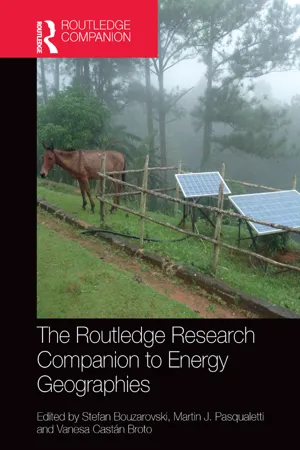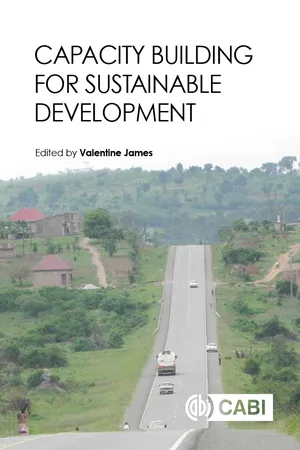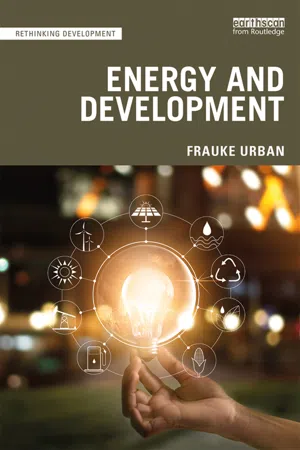Geography
Energy Consumption
Energy consumption refers to the amount of energy used by individuals, organizations, or countries. It is measured in units such as kilowatt-hours (kWh) or joules (J) and is influenced by factors such as population size, economic development, and technological advancements.
Written by Perlego with AI-assistance
Related key terms
Related key terms
1 of 4
Related key terms
1 of 3
3 Key excerpts on "Energy Consumption"
- Stefan Bouzarovski, Martin J Pasqualetti, Vanesa Castán Broto(Authors)
- 2017(Publication Date)
- Routledge(Publisher)
This book aims to contribute towards the development of an explicitly geographical perspective on energy. We explore the scale- and place-dependent nature of the relationship between the material and technical properties of energy circulations, on the one hand, and different types of social formations — individuals, households, communities — on the other. One of our starting points is that the geography of energy is relevant at every scale and in every realm. This leads us to ask questions about the types of places and spaces that are associated with increased greenhouse gas emissions, as well as the patterns of uneven development and resource consumption that drive this disparity. The location of energy reserves has affected national, regional and local economies, as well as the balance of political power. Energy circulations are implicated in shaping our lives, values and cultures, while being enmeshed with the grain of everyday life: Which forms of social interaction can be linked to Energy Consumption? How might the changing nature of energy demand promote the development of an alternative socio-technical future, predicated upon more sustainable forms of Energy Consumption and production?These and other questions are increasingly becoming the central concern of many strands of geographical inquiry. ‘Energy’ is explicitly recognized as a structural force in discussions of issues such as climate change, environmental impacts, urban restructuring and identity formations. At the same time, there is a rising engagement between the interdisciplinary field of energy research, on the one hand, and spatial issues and themes, on the other — as evidenced by the prominence of issues of place and territory in debates on low carbon transition and security. Geographical considerations have also become more apparent in international debates on carbon regulation, regional policy and market reform. The black box of demand and culture in geographical energy research is increasingly becoming unpacked, especially in terms of the everyday routines that underpin Energy Consumption within different material sites. Debates around locations and processes of energy production take into account the complex energy chains that allow various fuels and services to be distributed across wide geographical areas.With such developments in mind, this volume aims to provide an integrated perspective on the relationship between energy and geography. The chapters presented here form the contours of a geographical framework for studying the multiple facets of security, sustainability, space and place as they relate to energy, while foregrounding such themes in current debates within the disciplines of human geography, planning, environmental science, economics and political science. A range of policy relevant strands emerge from the application of a geographical perspective on energy in the domains of security, social justice, and environment. As such, the Companion responds to an important lacuna in the academic, educational and publicist literature, where book contributions on energy topics are mostly focused on issues of supply, and emphasize either technical, engineering or regional aspects of energy use.- eBook - ePub
- Valentine Udoh James, Valentine Udoh James(Authors)
- 2018(Publication Date)
- CAB International(Publisher)
It is also important to define the three terms commonly used in energy studies, i.e. energy resources, energy reserves and global Energy Consumption. Energy resources denote an estimate of the total quantity of energy resources available that may be exploited and used by humans, while energy reserve is that portion of the resources which has been ascertained scientifically and can be economically recovered with available techniques. Global Energy Consumption is the total energy use by all of human civilization. It involves all energy harnessed from every source for human endeavours across every industrial and technological sector and across every country and is typically measured annually. The key global energy monitoring institutions include the International Energy Agency (IEA), the US Energy Information Administration and the European Environment Agency. These agencies, among others, record and publish energy data periodically.Sustainable development
Development has been described as an aggregate of the processes aimed at improving the living conditions and circumstances of human beings both directly and indirectly. It may involve the use of material resources, space and amenities with the primary aim of promoting human wellbeing. Development is, therefore, basically about achieving improvements in ways of managing natural and human resources to create wealth and improve people’s lives. It is often propelled by exigencies and sometimes through natural processes. Sustainable development, by its original definition, is that mode of human development that meets the needs of the present without compromising the ability of future generations to meet their own needs (UNISDR, 2009 ). As shown in Fig. 16.1 , the United Nations asserts that the components that work together to produce sustainable development are: economic development; social development; and environmental protection (UN General Assembly, 2005 ). The social aspect addresses the need to maintain the stability of social and cultural systems, preservation of cultural diversity and cultural capital, and the better use of knowledge of sustainable practices embedded in less dominant cultures, etc. while the environmental component focuses on the stability of biological and physical systems (Adenikinju, 2012 - eBook - ePub
- Frauke Urban(Author)
- 2019(Publication Date)
- Routledge(Publisher)
2 Energy use and energy systems in different countries and contexts Energy and energy systems for development: key issues Key definitions Energy use refers to the consumption of energy. For example, energy can be used by households or industries, for a wide range of purposes and end-uses. Energy demand refers to the energy that is demanded or needed by customers. It involves the customer’s willingness and ability to pay or access a specific energy service or energy product. For example, demand for electricity is highest during peak times such as in the evenings when lighting is needed. Demand for fuelwood is high in many developing countries, particularly for cooking. Energy supply is defined as the delivery of a fuel for consumption. To achieve energy supply, several processes can be involved, such as energy extraction, generation, transmission, distribution and storage of fuels. For example, electricity is supplied to grid-connected customers. The term energy system refers to an interrelated network of energy sources, connected by transmission and distribution of that energy to where it is needed. An energy system encompasses the production, generation, transmission and use of energy, including its technology. For example, a grid-based energy system includes the sourcing of energy resources, the power stations or energy technology that generate the electricity, the transmission lines and converter stations that transmit the electricity as well as the end-uses that consume the energy. Energy carrier refers to a substance or system that contains potential energy that can be released and used as actual energy in the form of mechanical work or heat or to operate chemical and physical processes. Energy carriers include batteries, coal, dammed water, electricity, hydrogen, natural gas, petrol and wood
Index pages curate the most relevant extracts from our library of academic textbooks. They’ve been created using an in-house natural language model (NLM), each adding context and meaning to key research topics.
Explore more topic indexes
Explore more topic indexes
1 of 6
Explore more topic indexes
1 of 4


